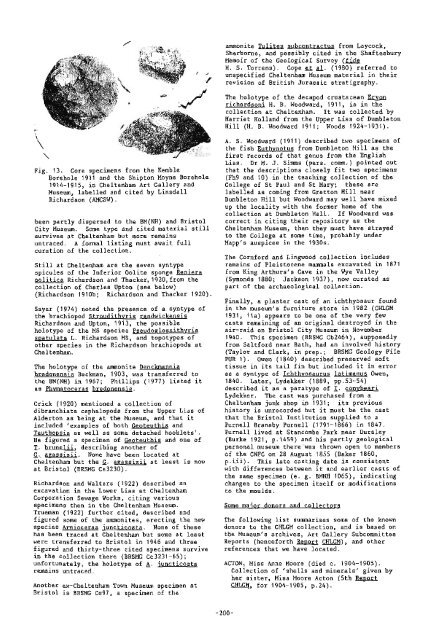Number 5 - Geological Curators Group
Number 5 - Geological Curators Group
Number 5 - Geological Curators Group
You also want an ePaper? Increase the reach of your titles
YUMPU automatically turns print PDFs into web optimized ePapers that Google loves.
ammonitesubcontractus from Laycock,Sherbarne, and possibly cited in the ShaftesburyMemoir of the <strong>Geological</strong> Survey (fideH. S. Torrens). Cope d. (1980) referred tounspecified Cheltenham Museum material in theirrevision of British Jurassic stratigraphy.The holotype of the decapod crustacean mrichardsoni H. B. Woodward, 1911, is in thecollection at Cheltenham. It was collected byHarriet Holland from the Upper Lias of DumbletonHill (H. B. Woadward 1911; Woods 1924-1931).Fig. 13. Core specimens from the KembleBorehole 1911 and the Shipton Moyne Borehole1914-1915, in Cheltenham Art Gallery andMuseum, labelled and cited by LinsdallRichardson (AMCSW).been partly dispersed to the BM(NH) and BristolCity Museum. Some type and cited material stillsurvives at Cheltenham but more remainsuntraced. A formal listing must await fullcuration of the collection.Still at Cheltenham are the seven syntypespicules of the Inferior Oolite sponge Renieraoolitica Richardson and Thacker,1920,from thecollection of Charles Upton (see below)(Richardson 1910b; Richardson and Thacker 1920)Sayer (1974) noted the presence af a syntype ofthe hrachiopod Stroudithvris randwickensisRichardson and Upton, 1913, the possibleholotype of the MS species Pseudoelossithvriss~atulata L. Richardson MS, and tapotypes ofother species in the Richardson brachiopods atCheltenham.The holotype of the ammonite Denckmanniabredonensis Buckman, 1903, was transferred tothe BM(NH) in 1967; Phillips (1977) listed itas Phmnatoceras -.Crick (1920) mentioned a collection ofdibranchiate cepbalopods from the Upper Lias ofAlderton as being at the Museum, and that itincluded 'examples of both Geoteuthis andTeuthapsis as well as some detached hooklets'.He figured a specimen of Geoteuthis and one ofT. hrunelii, describing another of- G. aeassizii. None have been located at~Cheltenham but the G. agassizii at least is nowat Bristol (BRSMG Ce3230).Richardson and Walters (1922) described anexcavation in the Lower Lias at CheltenhamCorporation Sewage Works, citing variousspecimens then in the ~heltenham Museum.Trueman (1922) further cited, described andfi~ured some of the ammonites. erecting the newspecies Arniaceras W. None of thesehas been traced at Cheltenham but same at leastwere transferred to Bristol in 1946 and threefigured and thirty-three cited specimens survivein the collection there (BRSMG Ce3231-65);unfortunately, the holotype of A. juncticostaremains untraced.Another ex-Cheltenham Town Museum specimen atBristol is BRSMG Ce97, a specimen of theA. S. Woodward (1911) described two specimens ofthe fish Euthvnotus from Dumbleton Hill as thefirst records of that genus from the EnglishLias. Dr M. J. Simms (pers. corn.) pointed outthat the descriptions closely fit two specimens(Fh9 and 10) in the teaching collection of theCollege of St Paul and St Mary; these arelabelled as coming from Gretton Hill nearDumbleton Hill but Woodward may well have mixedup the locality with the former home of thecollection at Dumbleton Hall. If Woodward wascorrect in citing their repository as theCheltenham Museum, then they must have strayedto the College at some time, probably underMapp's auspices in the 1930s.The Cornfard and Lingwood collection includesremains of Pleistocene mammals excavated in 1871from King Arthurs's Cave in the Wye Valley(Symonds 1880; Jackson 1937), now curated aspart of the archaeological collection.Finally, a plaster cast of an ichthyosaur foundin the museum's furniture store in 1982 (CHLGM1931, 1la) appears to be one of the very fewcasts remaining of an original destroyed in theair-raid on Bristol City Museum in November1940. This specimen (BRSMG Cb2464), supposedlyfrom Saltford near Bath, had an involved history(Taylor and Clark, in prep.; BRSMG Geology FilePUR 1). Owen (1840) described preserved softtissue in its tail fin but included it in erroras a syntype of Ichthvosaurus latimanus Owen,1840. Later, Lydekker (1889, pp.53-54)described it as a paratype of I. convheariLydekker. The cast was purchased from aCheltenham junk shop in 1931; its previoushistory is unrecorded but it must be the castthat the Bristol Institution supplied to aPurnell Bransby Purnell (1791-1866) in 1847.Purnell lived at Stancombe Park near Dursley(Burke 1921, p.1459) and his partly geologicalpersonal museum therewas thrown open to membersof the CNFC an 28 August 1855 (Baker 1860,p.iii). This late casting date is consistentwith differences between it and earlier casts ofthe same specimen (e. g. BMNH 1065), indicatingchanges to the specimen itself or modificationsto the moulds.Some maior donors and collectorsThe following list summarises some of the knowndonors to the CHLGM collection, and is based onthe Museum's archives, Art Gallery SubcommitteeReports (henceforth m CHLGM), and otherreferences that we have located.ACTON, Miss Anne Moore (died c. 1904-1905).Collection of 'shells and minerals' given byher sister, Miss Moore Acton (5thWBI, for 1904-1905, p.24).
















